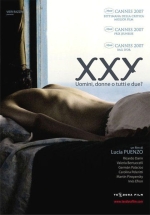Damned If You Do, Damned If You Don't
2009 // Denmark // Lars von Trier // November 3, 2009
// Theatrical Print (Landmark Tivoli Theater)
B - Antichrist is an aggressively unpleasant film, but that's not the same thing as a bad film. In fact, the latest effort from Lars von Trier, the noted asshole and self-appointed ambassador of pretentious European film-making, is the most intriguing work from the director I've yet seen. I have never understood the contempt his films often arouse, but my prior experience with von Trier has been admittedly underwhelming. Antichrist, however, proves to be audacious and original. The film is suffused with unforgettable images, seemingly plucked out of a bad dream and given a rotten, mythic life on the screen. Von Trier has achieved a fresh alchemy, blending his essential cynicism with intellectually engrossing themes and a new-found instinct for terror. While a bothersome lack of emotional heft prevents it from succeeding as a genuine work of horror, Antichrist is nonetheless harrowing, provocative stuff. It seems ordained to lurk in the cellar of cinema for years to come, it noisome bellows drawing attention to our unexamined assumptions about remorse, sex, and especially gender. You are forewarned: von Trier has summoned forth an ugly, ugly beast, and staring it down is not enjoyable in the least, but there is something nonetheless compelling in its scabrous eyes.
The film declares its interests with full-throated conviction in an unbearably gorgeous prologue, shot in luminous black-and-white and presented in ultra-slow motion. While an aria from Handel's Rinaldo evokes a sacred tone, the nameless He (Willem Dafoe) and She (Charlotte Gainsbourg) engage in some apparently mind-shattering shower sex that eventually migrates to floor and bed. So rapturous is their lovemaking that the couple fails to notice when their toddler son leaps from his crib, opens a baby gate, climbs on a table, and steps out an open window, plummeting to a sumptuously captured death. Here von Trier entwines sex and death by means of style and storytelling, muddling their flavors to create a concoction that is simultaneously horrific and ecstatic.
She is hospitalized following the funeral, once it becomes apparent that the tragedy has utterly broken her will to live. He, a psychotherapist simmering with restrained intellectual arrogance, decides that her treatment is not working, and resolves to bring his wife home, take her off medication, and subject her to his brand of therapy. Eventually, he brings her to Eden, a cabin in the woods where she once labored on a dissertation on the history of misogynistic violence. What exactly transpires in the forest I won't say, except that it revolves around the power struggle between this devious, controlling man and this astute woman who is in a vulnerable state, and possibly losing her mind.
It's worth taking a moment here to dispose of any suspicion that von Trier, whose films have always maintained a chilly distance from his characters while subjecting them to nasty circumstances, exhibits anything like warmth for these people. He and She are potent symbols, constructed explicitly for the purpose of Antichrist's exploration of repressed fears, but they aren't really characters. We dread for them, but only because von Trier does such an exquisite job of suggesting looming calamity. And when the blood starts to fly, it's horrifying strictly because--as in Argento's baroque nightmares and the countless Saws and Hostels--we can readily imagine the pain. However, von Trier achieves something infinitely more stimulating and disturbing than mere art-house torture porn, because he tethers the scattered moments of gore to a stimulating story steeped in the elements. Spilled blood and rent flesh fit comfortably within Antichrist's motifs of natural savagery and ugliness: snow, rain, hail, gnarled trees, bloated ticks, falling acorns, and woodland animals that ooze with sinister portent.
The novelty of Antichrist is its frank tackling of matters often neglected by "serious" cinema, and long buried as a subtext in genre film, especially horror. Von Trier has presented one of first films that I can recall to explicitly invoke and critique the Othering of a gender, an Othering that goes far beyond run-of-the-mill dehumanization into outright demonization. The fundamental terror that Antichrist exploits is androphobia-gynophobia, a fear that the other gender is alien, frightening, unfathomable, and, above all, Evil. The film's cosmology--or at least the cosmology that threatens to intrude on its secular starting point--is a Manichaean one, where goodness resides in the spiritual and evil dwells in the material. With admirable agility, von Trier ties this worldview to a Christian-pagan conception of the link between nature and feminine power. Satan is manifest in the natural world; women are attuned to the natural world; ergo, women are emissaries of Satan. In her dissertation, entitled "Gynocide," Gainsbourg's She attempted to refute this superstitious and misogynistic nonsense, illustrating how it once led to witch burnings. However, one of von Trier's theses in Antichrist is the seductive nature of sexist mythologizing. Even those who should know better can fall victim to ancient bigotries, especially when they dovetail neatly with unresolved anxieties and festering traumas.
This isn't to say that She is villain of Antichrist. It's debatable whether the term is even applicable to von Trier's fable, which is intriguingly ambiguous despite the spiritual and fleshy terror it engenders. Indeed, one of the film's low-key achievements is its uncanny portrayal of a male antagonist who is outwardly selfless and reasonable but whose actions are manipulative and domineering. Dafoe's He is a supremely subtle kind of monster, whose unflappable confidence and insipid psychological exercises hold a seed of the sinister, one that only expands as the film unspools (and unravels). At one point, He tosses aside any pretense of equality or humanity in his relationship with She, retorting "You don't have to understand; just do what I say." Von Trier's cynicism has always unshackled him from facile and flaccid romantic conventions, especially the archetypes of the Good Guy and Bad Guy. His films insist that we are all bad guys. This attitude has often led to dismal aimlessness in his films, but in Antichrist, the director exhibits a taut confidence with contradiction. He is resolute in the portrayal of He as a fundamentally despicable man, even as he provokes our pity at the horrors He endures.
Van Trier unfortunately relies on unnecessary excess in Antichrist's final act. The film's grisliest moments aren't enhanced by the director's unflinching devotion to capturing every bloody detail. It doesn't demand much skill to provoke squirming discomfort from an audience with gratuitous shots of battered, pierced, and snipped flesh. This is especially unsatisfactory given that von Trier elsewhere exhibits a hitherto unforeseen talent for restrained horror. Following in the tradition of Cronenberg at his most surreal and Lynch at his finest, von Trier renders the most banal locales with a Luciferian menace. Consistent with his theme of a natural world suffused with evil, he persuades through unnerving visuals and sound design, evoking a setting where, for example, a rustling stand of ferns becomes a lair for unfathomable malice. It is this vital instinct for the uncanny that lends the film its powerful atmosphere of dread. We are unsettled, yet we don't know why. We fear something, but we don't know what. (Or at least we cannot or will not say it out loud.) The aloofness that von Trier stubbornly refuses to shake--or simply can't shake--does nothing to diminish Antichrist's skin-crawling potency. More like this, please, Lars.









